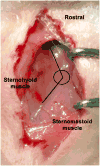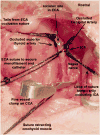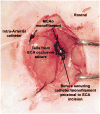Concurrent middle cerebral artery occlusion and intra-arterial drug infusion via ipsilateral common carotid artery catheter in the rat
- PMID: 23261656
- PMCID: PMC3570629
- DOI: 10.1016/j.jneumeth.2012.12.004
Concurrent middle cerebral artery occlusion and intra-arterial drug infusion via ipsilateral common carotid artery catheter in the rat
Abstract
Pre-clinical development of therapy for acute ischemic stroke requires robust animal models; the rodent middle cerebral artery occlusion (MCAo) model using a nylon filament inserted into the internal carotid artery is the most popular. Drug screening requires targeted delivery of test substance in a controlled manner. To address these needs, we developed a novel method for delivering substances directly into the ischemic brain during MCAo in the awake rat. An indwelling catheter is placed in the common carotid artery ipsilateral to the occlusion at the time of the surgical placement of the occluding filament. The internal and common carotid arteries are left patent to allow superfusion anterograde. The surgeries can be completed quickly to allow rapid recovery from anesthesia; tests substances can be infused at any given time for any given duration. To simulate clinical scenarios, the occluding filament can be removed minutes or hours later (reperfusion) followed by therapeutic infusions. By delivering drug intra-arterially to the target tissue, "first pass" loss in the liver is reduced and drug effects are concentrated in the ischemic zone. To validate our method, rats were infused with Evans blue dye either intra-arterially or intravenously during a 4 h MCAo. After a 30 min reperfusion period, the dye was extracted from each hemisphere and quantitated with a spectrophotometer. Significantly more dye was measured in the ischemic hemispheres that received the dye intra-arterially.
Copyright © 2012 Elsevier B.V. All rights reserved.
Conflict of interest statement
The authors have no conflict of interest.
Figures








Similar articles
-
A new middle cerebral artery occlusion model for intra-arterial drug infusion in rats.Neurosci Lett. 2015 Oct 21;607:102-107. doi: 10.1016/j.neulet.2015.09.020. Epub 2015 Sep 21. Neurosci Lett. 2015. PMID: 26399437
-
A System for Continuous Pre- to Post-reperfusion Intra-carotid Cold Infusion for Selective Brain Hypothermia in Rodent StrokeModels.Transl Stroke Res. 2021 Aug;12(4):676-687. doi: 10.1007/s12975-020-00848-3. Epub 2020 Sep 10. Transl Stroke Res. 2021. PMID: 32910341 Free PMC article.
-
Spontaneous hyperthermia and its mechanism in the intraluminal suture middle cerebral artery occlusion model of rats.Stroke. 1999 Nov;30(11):2464-70; discussion 2470-1. doi: 10.1161/01.str.30.11.2464. Stroke. 1999. PMID: 10548685
-
[Establishment and evaluation of reproduction of middle cerebral artery occlusion to produce cerebral ischemia with autologous blood clot and nylon thread in rat].Zhongguo Wei Zhong Bing Ji Jiu Yi Xue. 2006 May;18(5):272-4. Zhongguo Wei Zhong Bing Ji Jiu Yi Xue. 2006. PMID: 16700989 Chinese.
-
The IMPROVE Guidelines (Ischaemia Models: Procedural Refinements Of in Vivo Experiments).J Cereb Blood Flow Metab. 2017 Nov;37(11):3488-3517. doi: 10.1177/0271678X17709185. Epub 2017 Aug 11. J Cereb Blood Flow Metab. 2017. PMID: 28797196 Free PMC article. Review.
Cited by
-
Direct thrombin inhibitor argatroban reduces stroke damage in 2 different models.Stroke. 2014 Mar;45(3):896-9. doi: 10.1161/STROKEAHA.113.004488. Epub 2014 Jan 28. Stroke. 2014. PMID: 24473182 Free PMC article.
-
How to Pick a Neuroprotective Drug in Stroke Without Losing Your Mind?Life (Basel). 2025 May 30;15(6):883. doi: 10.3390/life15060883. Life (Basel). 2025. PMID: 40566537 Free PMC article. Review.
-
Differential Vulnerability and Response to Injury among Brain Cell Types Comprising the Neurovascular Unit.J Neurosci. 2024 May 29;44(22):e1093222024. doi: 10.1523/JNEUROSCI.1093-22.2024. J Neurosci. 2024. PMID: 38548341 Free PMC article.
-
Impact of Cholesterol on Ischemic Stroke in Different Human-Like Hamster Models: A New Animal Model for Ischemic Stroke Study.Cells. 2019 Sep 4;8(9):1028. doi: 10.3390/cells8091028. Cells. 2019. PMID: 31487778 Free PMC article.
-
Absolute Cerebral Blood Flow Infarction Threshold for 3-Hour Ischemia Time Determined with CT Perfusion and 18F-FFMZ-PET Imaging in a Porcine Model of Cerebral Ischemia.PLoS One. 2016 Jun 27;11(6):e0158157. doi: 10.1371/journal.pone.0158157. eCollection 2016. PLoS One. 2016. PMID: 27347877 Free PMC article.
References
-
- Bederson JB, Pitts LH, Tsuji M, Nishimura MC, Davis RL, Bartkowski H. Rat middle cerebral artery occlusion: evaluation of the model and development of a neurologic examination. Stroke. 1986;17:472–6. - PubMed
-
- Belayev L, Alonso OF, Busto R, Zhao W, Ginsberg MD. Middle cerebral artery occlusion in the rat by intraluminal suture. Neurological and pathological evaluation of an improved model. Stroke. 1996;27:1616–22. discussion 23. - PubMed
-
- Chen B, Cheng Q, Yang K, Lyden PD. Thrombin mediates severe neurovascular injury during ischemia. Stroke. 2010;41:2348–52. - PubMed
Publication types
MeSH terms
Substances
Grants and funding
LinkOut - more resources
Full Text Sources
Other Literature Sources

